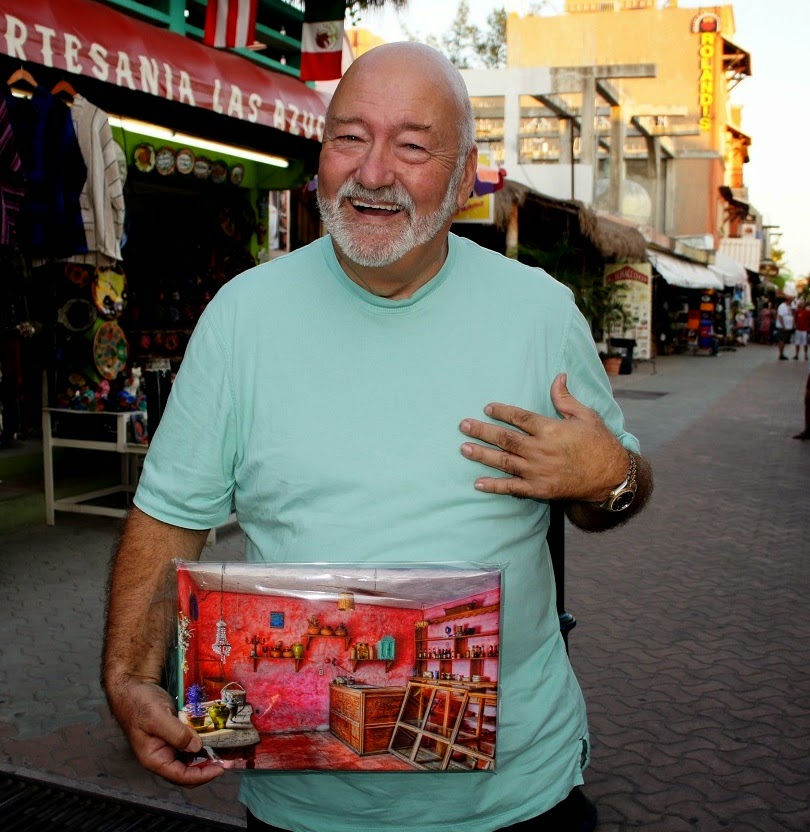 |
| Breadman in Centro |
Yes,
I know, I recently wrote about “Unusual Jobs, Not Available in
Canada,” but it is a subject that continues to intrigue us, the
ingenious ways that hardworking islanders earn a living.
The most
visible are the street vendors who walk or cycle daily around the
neighbourhoods, many with their individual sales pitch or chant,
anything to get the attention of potential customers.
Every
morning around dawn, when I am out walking our little dog Sparky, a
middle-aged man pedals his heavy bicycle cart along our street. The
cart is so heavy that he is forced to get off and push it up the two
not-quite hills.
As he passes, he calls out to the construction
workers who are just starting their day: “Hay tamales. Hay
masa.” It roughly translates to: Here are tamales,
here is masa. Masa is a very popular corn dough used for
making tortillas or tamales.
 |
| One of the Tamale salesmen |
Many
construction workers typically live on site to provide security for
building supplies until the house is completed. Grocery stores are
not always nearby, and the labourers really appreciate having cooked
food delivered to their workplace.
Filled with bits of chicken or
pork, spices, onions, and chillies, the substantial tamales provide
much-needed nutrition at the start of a long, hot workday.
 |
| Construction workers appreciate cooked food delivery |
The
question that flickers through my brain when I see the tamale
salesman is: How early does he get up if he is already pedalling past
our house at six in the morning? Does his wife stay up all night to
prepare the tamales, trying to sleep during the frequently noisy and
hot daylight hours?
 |
| Youngster selling corn |
Even
youngsters frequently pitch in to help out with family finances.
A while ago, when we were visiting friends at the Guadalupana
settlement, I noticed a young teen pedalling his bicycle cart through
the neighbourhood. He was selling cooked corn on the cob.
Presumably, mom or an older sister did the preparation, and he was
responsible for selling the product. It's a good lesson in economics
and business for the young man, but at the same time, I am sure he
would rather be swimming in the ocean or hanging out with his
buddies.
 |
| Mamey salesmen arriving on Isla via car ferry |
As
the day progresses and the heat increases, several vendors are out
and about, selling everything from seasonal vegetables to cheese,
tortillas, bread, ice cream treats, clay pots, and woven mats and
bags. They trudge the streets with display cases confidentially
balanced on their heads, or they trundle along the sidewalks with
hand carts piled high with seasonal treats such as lychee nuts, or
mamey fruit.
Shaped like a small rough-skinned football, the
orangey-red flesh of a mamey has an intriguing flavour, tasting like
a combination of sweet potato, pumpkin and peach. Islanders enjoy
mamey as a wintertime treat.
 |
| Mid-afternoon snack break |
Later
in the evening, the food carts congregate in convenient locations
offering hamburgers, hot dogs, tacos or desserts. Businesses
supplying take-out meals or home delivery proliferate around the
island. Few homes have large refrigerators to stockpile fruits,
vegetables and meat. Most meals are prepared on small gas stoves,
similar to a Coleman or a two-burner hot plate. It boggles the mind
to think of how many people make a living supplying food to other
islanders.
In
many ways, the food culture in Mexico resembles European habits.
Eating out at any one of the many economical street-side restaurants
is common.
For those who cook at home, daily shopping turns a
potentially onerous chore into a social event. Locals gossip with
other shoppers as they gather up items for the day's meals. It's not
about rushing around and piling items in a cart.
 |
| Evening treats! |
Local people are ingenious at finding ways to earn a living. They work long hours, frequently at physically demanding jobs. They also enjoy life.
Hasta luego, Lawrie, Lynda, Sparky, and Thomas the Cat
Murder. Mayhem. Revenge. Romance.

%20Instagram%20%231.jpg)


















